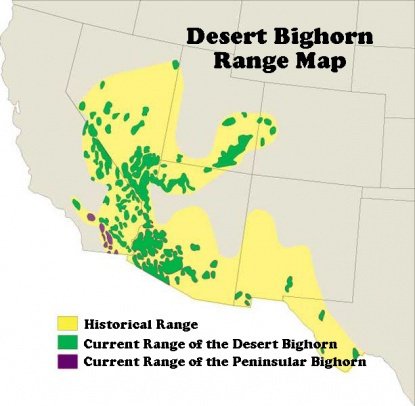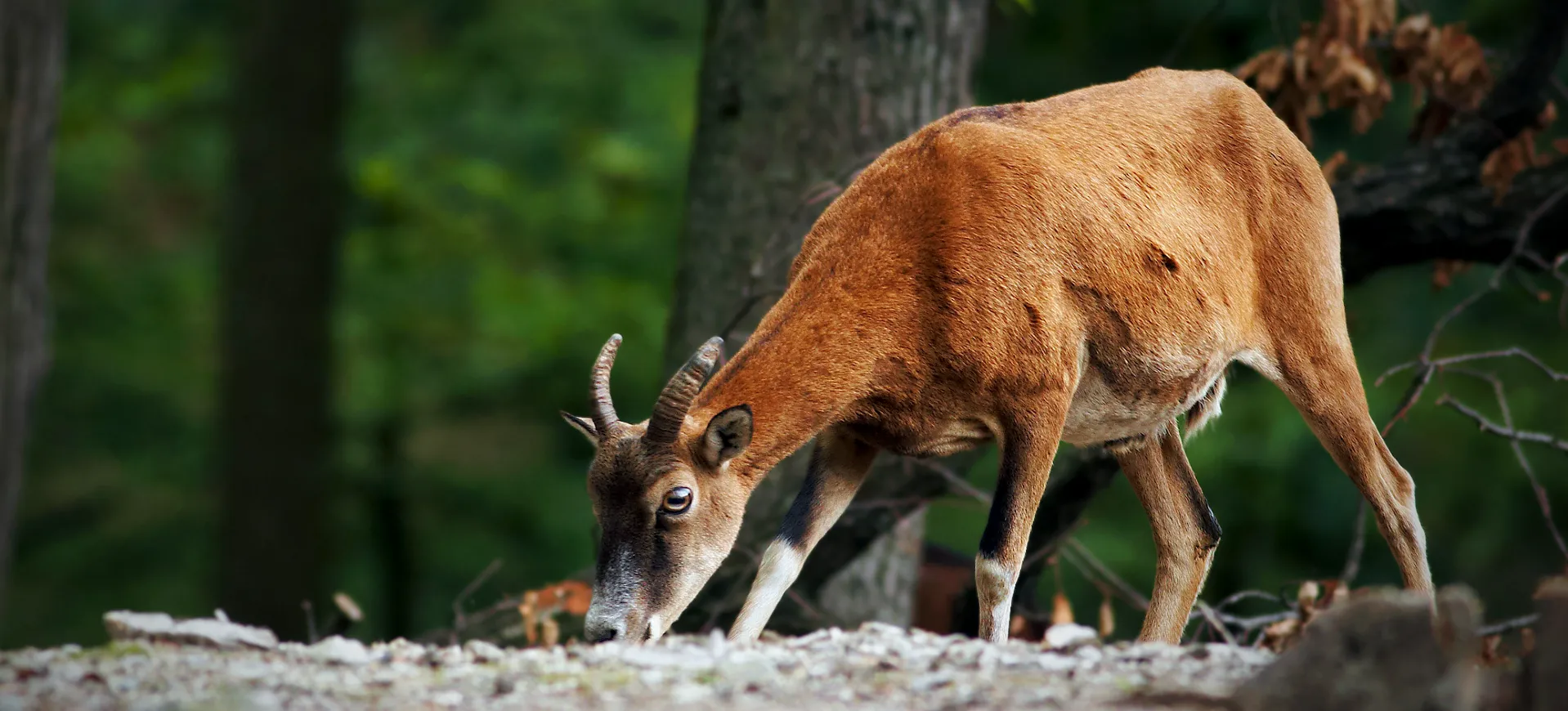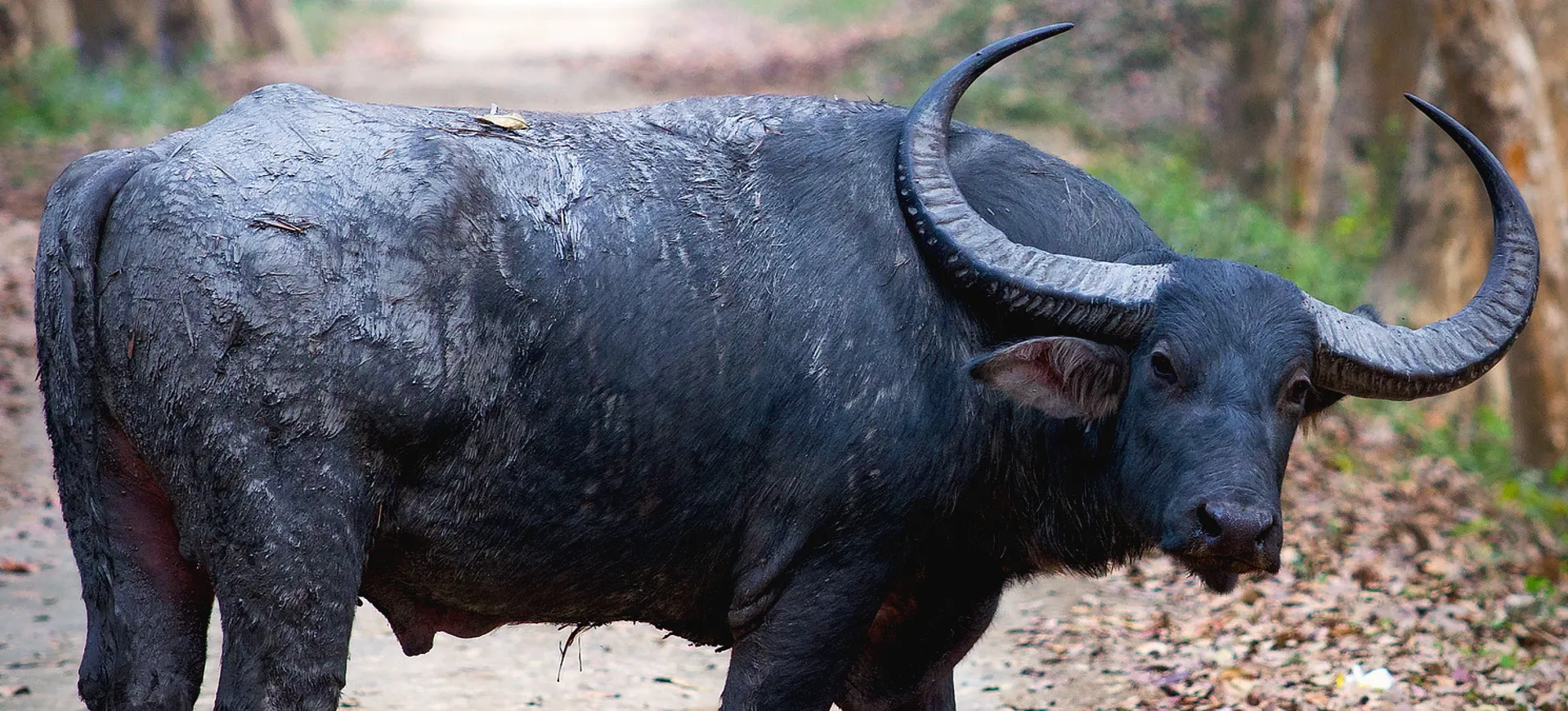Overview
Desert Bighorn Sheep (Ovis canadensis nelsoni) are a distinct subspecies of the North American Bighorn Sheep, adapted to life in the arid deserts of the southwestern United States and northern Mexico. Characterized by their large, curled horns, which are much heavier in males than females, these sheep are renowned for their agility and balance, which allow them to navigate the rocky, rugged terrain of their habitat. Their coats are lighter in color compared to their mountain-dwelling relatives, providing camouflage against the desert backdrop. Desert Bighorn Sheep are gregarious animals that form herds of varying sizes, which helps protect against predators.
Desert Bighorn Sheep’s social structure is based on gender and age, with separate herds for adult males and females outside of the breeding season. Males, known as rams, are typically solitary or form small bachelor groups, while females, known as ewes, stay in larger groups with their young. This separation helps reduce competition for resources among adults and increases the survival chances of the lambs by centralizing care. During the rut, rams compete for dominance and mating rights through dramatic displays of head-butting.
Desert Bighorn Sheep are specially adapted to their harsh desert environment, with adaptations such as highly efficient water metabolism that allows them to go without water for several days. They feed on various desert plants, which they digest with their multi-chambered stomach, maximizing nutrient uptake in a sparse food environment. Despite these adaptations, Desert Bighorn Sheep are vulnerable to habitat loss, diseases transmitted by domestic animals, and climate change, all of which pose significant threats to their populations.
Taxonomy
Kingdom
Phylum
Class
Order
Family
Genus
Species
Sub Species
Type
Current distribution:
Desert Bighorn Sheep have diminished in range over the past century due to various human impacts, including habitat fragmentation, development, and the introduction of diseases from domestic livestock. Conservation efforts have aimed to reintroduce populations into their historic range, and currently, they can be found in several protected areas across their native territory.
Despite these efforts, the population remains fragmented, and many herds are isolated from each other, which can lead to genetic bottlenecks. Maintaining connectivity between habitats is crucial for the species' long-term survival, allowing for gene flow and greater genetic diversity.
Physical Description:
Desert Bighorn Sheep are medium-sized animals, robustly built with large, muscular bodies adapted for climbing and sudden bursts of speed. Adult males are significantly larger than females, with some rams weighing over 200 pounds, while ewes typically weigh less. Both sexes sport horns, but those of the rams are much larger and more curved, sometimes forming a complete spiral. Their coats change seasonally, thicker in the winter to provide warmth and thinner during the hot summer to allow heat dissipation.
The coloration of their fur, a dusty brown with a white belly and rump, helps them blend into the rocky desert landscapes that are their home. Their split hooves are uniquely adapted to provide traction on the steep, often loose, rocky slopes, enabling them to escape predators with remarkable agility. This combination of physical traits not only aids in their survival from predation but also facilitates access to the sparse vegetation on which they feed.

Lifespan: Wild: ~10 Years || Captivity: ~20 Years

Weight: Male: 160-220 lbs (73-100 kg) || Female: 75-120 lbs (34-54 kg)

Length: Male: 50-62 in (127-158 cm) || Female: 45-55 in (114-140 cm)

Height: Male: 32-38 in (81-97 cm) || Female: 30-36 in (76-91 cm)

Top Speed: 30 mph (48 km/h)
Characteristic:
Native Habitat:
Desert Bighorn Sheep are native to the desert regions of the Southwestern United States and northern Mexico, including the Mojave Desert, Sonoran Desert, and Chihuahuan Desert. They thrive in arid, rocky mountain ranges where steep, rugged terrain provides a refuge from predators and a vantage point for spotting threats from a distance.
Their habitat preferences include steep, rocky cliffs and outcrops interspersed with sparse vegetation, which offers both sustenance and minimal cover to avoid predators. The extreme conditions of their habitat necessitate remarkable adaptations, making the Desert Bighorn Sheep a symbol of resilience and survival in harsh environments.
Climate Zones:
Biomes:
WWF Biomes:
Biogeographical Realms:
Continents:
Countries:
Diet:
Diet & Feeding Habits:
Desert Bighorn Sheep are herbivores, feeding on a varied diet of grasses, shrubs, and forbs, which change seasonally based on availability. They travel considerable distances to find suitable food, which is scarce in the desert environment. During drought, they rely heavily on their ability to metabolize water from the vegetation they consume, reducing their need to drink water directly.
Their ruminant digestive system is highly efficient, allowing them to extract maximum nutrition from the tough, fibrous plants of the desert. To avoid the midday heat, feeding primarily occurs during the cooler parts of the day, early morning and late afternoon. This behavior conserves energy and reduces the risk of predation as they feed in more shadowed, less visible areas.
Mating Behavior:
Mating Description:
Desert Bighorn Sheep exhibit a polygynous mating system, in which dominant rams compete for access to ewes during the breeding season, known as the rut. This competition involves dramatic clashes in which rams charge each other, colliding their horns with great force to establish dominance and mating rights. The sounds of these clashes can be heard echoing through the mountains.
The rut occurs in the fall, and following a gestation period of approximately six months, ewes give birth to one, sometimes two lambs in late spring. Lambing season is a critical time when ewes seek isolated, rugged terrain to give birth, providing their young with the best chance of survival against predators. Lambs are agile within hours of birth, quickly learning to navigate their difficult environment under the watchful eyes of their mothers.
Reproduction Season:
Birth Type:
Pregnancy Duration:
Female Name:
Male Name:
Baby Name:
Social Structure Description:
Desert Bighorn Sheep exhibit a complex social structure that is pivotal for survival in their harsh desert environments. Outside the breeding season, rams and ewes live in separate groups that only come together during the rut, when rams display their fitness through intense physical contests. These contests and displays establish a hierarchy among the rams, determining access to resources and mating opportunities with the ewes, which can influence genetic diversity and herd health.
The social dynamics within the herds serve multiple survival functions; they provide collective vigilance against predators, such as mountain lions, which might otherwise target isolated individuals. Ewes benefit particularly from group living by collaboratively rearing their young in nurseries, where several mothers look out for the lambs. This strategy not only maximizes the young’s chances of survival by reducing the individual burden on any single mother but also teaches the lambs critical survival and social skills they will need as they grow.
Groups:
Conservation Status:
Population Trend:
While the Desert Bighorn Sheep is generally classified as “Least Concern” by conservation standards, this classification can be misleading as local populations exhibit significant variations in size and stability. In some areas, these populations are robust and thriving, while in others, they are critically small and struggling to recover. Conservation initiatives, including habitat restoration and disease management, have stabilized many vulnerable groups.
The reintroduction of Desert Bighorn Sheep into historical ranges has played a vital role in their recovery, helping to counteract the declines caused by overhunting and competition with livestock. Additionally, habitat conservation efforts aim to preserve the natural environments necessary for survival, mitigating the impact of human-induced habitat loss. These conservation strategies are essential for maintaining the ecological balance and ensuring the long-term viability of Desert Bighorn Sheep populations across their native territories.
Population Threats:
Major threats to Desert Bighorn Sheep arise primarily from habitat loss and fragmentation. Urban development, mining, and road construction have severely disrupted their natural migration routes and breeding patterns, isolating populations and reducing genetic diversity. This fragmentation makes it difficult for sheep to access traditional feeding and breeding grounds and increases their vulnerability to predators and other environmental pressures.
Diseases transmitted by domestic sheep and goats, notably pneumonia, pose a significant risk to Desert Bighorn Sheep populations, leading to high mortality rates and long-term impacts on population recovery. Climate change further exacerbates these challenges by altering their arid habitats’ vegetation and water resources. As temperatures rise and droughts become more frequent, the survival of Desert Bighorn Sheep depends increasingly on concerted conservation efforts to effectively manage and mitigate these threats.
Conservation Efforts:
Conservation programs dedicated to Desert Bighorn Sheep aim to preserve their natural habitats and reduce the risk of disease transmission that has historically devastated populations. Key efforts include removing physical barriers that obstruct their traditional migration paths, thus facilitating natural movement and breeding practices essential for their survival. Moreover, legal protections are put in place to safeguard critical habitats from encroaching development and industrial activities, ensuring these areas remain undisturbed and conducive to the sheep’s way of life.
Additionally, reintroduction programs play a crucial role in the conservation strategy for Desert Bighorn Sheep by establishing new herds in areas where the species had previously dwindled or disappeared. These programs help increase the number and distribution of sheep and enhance genetic diversity within the species, which is vital for their overall resilience and adaptability to changing environmental conditions. By carefully managing human activities in sensitive regions and promoting the expansion of healthy, genetically diverse populations, conservationists work to secure a stable future for the Desert Bighorn Sheep across their historic range.
Additional Resources:
Fun Facts
- Desert Bighorn Sheep can go for several days without water, obtaining moisture from their food.
- The horns of a ram can weigh more than all the bones in his body combined.
- Unlike most other mammals, bighorn sheep can see behind themselves without turning their heads.
- Lambs can climb steep slopes within days of birth.
- Desert Bighorn Sheep have excellent vision. Their large eyes are situated on the sides of their heads, providing a wide field of view.
- Their unique hoof structure lets them grip smooth surfaces and jump precisely between rocks.
- Rams’ horns can grow throughout their lifetime and are used to determine their age.
- They are capable of withstanding extreme temperatures, both high and low.
- Desert Bighorn Sheep are considered an indicator species, reflecting the health of their desert ecosystem.
- They are culturally significant to many indigenous groups in North America, featuring prominently in art, mythology, and traditions.














































































